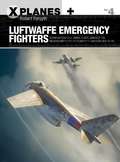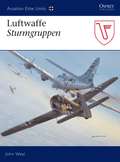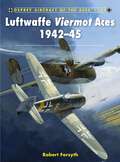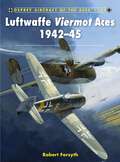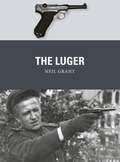- Table View
- List View
Luck of the Wheels (The Ki and Vandien Quartet #4)
by Megan LindholmA reissue of classic backlist titles from the author of the best selling Farseer Trilogy and The Liveship Traders books. LUCK OF THE WHEELS is the fourth and final book in THE WINDSINGERS series, which introduced her popular gypsy characters, Ki and Vandien.
Lucky Breaks
by Yevgenia BelorusetsCaptivating, innovative Ukrainian fiction about displaced women living in the shadow of the war with Russia'This singular collection brings Ukraine, "the land of residual phenomena," entirely to life' Kirkus ReviewsIn Lucky Breaks, we encounter anonymous women from the margins of Ukrainian society, their lives upended by the ongoing conflict with Russia. A woman, bewildered by her broken umbrella, tries to abandon it like a sick relative; a beautiful florist suddenly disappears, her shop converted into a warehouse for propaganda; hiding out from the shelling, neighbours read horoscopes in the local paper that tell them when it's safe for them to go outside.In stories of linguistic verve and absurdist wit, Yevgenia Belorusets writes of trauma amidst the mundane, telling surreal, unsettling tales of survival in a shattered country.
Lucky Johnny: The Footballer who Survived the River Kwai Death Camps (Spider Shephard Ser.)
by Johnny SherwoodIn 1938 Johnny Sherwood was a young professional footballer on the brink of an England career, touring the world with the all-star British team the Islington Corinthians. By 1942 he was a soldier surrendering to the Japanese at the siege of Singapore. Taken prisoner he was sent to a POW camp deep in the heart of the Thai jungle, where he was starved, beaten, and forced to build the notorious 'railway of death' on the River Kwai. Johnny kept his and his men's spirits up with tales of his footballing past, even organising matches until he and the other prisoners became too weak to play. One day, he even encountered a brutal Japanese guard, and was shocked to recognise him as a Japanese footballer Johnny had played against. Many years after Johnny's death, his grandson Michael discovered an old manuscript hidden in the attic of his mother's house. It was Johnny's own account of his wartime experiences - the story too horrific to reveal in full to his loved ones. In the tradition of bestselling memoirs like The Railway Man, Lucky Johnny is an inspirational tale of survival against the odds.
The Lucky One
by Nicholas SparksDo you believe in lucky charms?While in Iraq, U.S. Marine Logan Thibault finds a photo, half-buried in the dirt, of a woman. He carries it in his pocket, and from then on his luck begins to change.Back home, Logan is haunted by thoughts of war. Over time, he becomes convinced that the woman in the photo holds the key to his destiny. So he finds the vulnerable and loving Beth and a passionate romance begins.But Logan battles with the one secret he has kept from Beth: how he found her in the first place. And it is a secret that could utterly destroy everything they love . . .
A Lucky Sixpence: A dramatic and heart-warming Liverpool saga
by Anne BakerA poignant and dramatic saga set in Liverpool, perfect for fans of Katie Flynn, Annie Groves and Lyn Andrews. Praise for Anne Baker's Merseyside sagas: 'A stirring tale of romance and passion, poverty and ambition' Liverpool EchoIt's 1937 and for sisters Lizzie and Milly Travis there's nothing quite like the thrill of the funfair at New Brighton. Amid the bright lights and whirling rides, Lizzie wins a lucky sixpence on a stall - as well as the heart of a handsome stallholder.Ben McCluskey isn't the type of man Lizzie's respectable parents had in mind for her, nevertheless the young couple embark on a whirlwind romance. Lizzie's mother worries that history will repeat itself when Ben introduces her daughter to a world she never knew existed. And, as war looms, Milly realises that her sister's luck can't last for ever...
Luftwaffe: Strategy for Defeat, 1933–45 (Routledge Library Editions: WW2 #16)
by Williamson MurrayThis book, first published in 1985, is an in-depth analysis of the Luftwaffe in the Second World War, using previously untapped German archives and newly-released ‘Ultra’ intelligence records. It looks at the Luftwaffe within the context of the overall political decision-making process within the Third Reich. It is especially valuable for its careful study of industrial production and pilot losses in the conduct of operations.
Luftwaffe: Strategy for Defeat, 1933–45 (Routledge Library Editions: WW2 #16)
by Williamson MurrayThis book, first published in 1985, is an in-depth analysis of the Luftwaffe in the Second World War, using previously untapped German archives and newly-released ‘Ultra’ intelligence records. It looks at the Luftwaffe within the context of the overall political decision-making process within the Third Reich. It is especially valuable for its careful study of industrial production and pilot losses in the conduct of operations.
Luftwaffe Air & Ground Crew 1939–45 (Men-at-Arms)
by Mike Chappell Robert F StedmanThe Luftwaffe, honed in the Spanish Civil War, played a vital part in Germany's 'Blitzkrieg' victories in 1939-41. Badly overstretched by war on three fronts in 1942-44, it was crippled by an incompetent commander-in-chief, the losses among experienced aircrew, and shortage of fuel. In 1944-45 it faced a final battle of attrition in skies ruled by the Allies as the Eastern and Western pincers closed on the Reich; but until the very end the dwindling band of veteran pilots among them the greatest 'aces' the world has ever known presented a potent threat. This fact-packed review of Luftwaffe uniforms and flying kit is illustrated with rare personal photos, insignia charts, and two dozen meticulously detailed colour figures.
Luftwaffe Air & Ground Crew 1939–45 (Men-at-Arms #377)
by Mike Chappell Robert F StedmanThe Luftwaffe, honed in the Spanish Civil War, played a vital part in Germany's 'Blitzkrieg' victories in 1939-41. Badly overstretched by war on three fronts in 1942-44, it was crippled by an incompetent commander-in-chief, the losses among experienced aircrew, and shortage of fuel. In 1944-45 it faced a final battle of attrition in skies ruled by the Allies as the Eastern and Western pincers closed on the Reich; but until the very end the dwindling band of veteran pilots among them the greatest 'aces' the world has ever known presented a potent threat. This fact-packed review of Luftwaffe uniforms and flying kit is illustrated with rare personal photos, insignia charts, and two dozen meticulously detailed colour figures.
Luftwaffe Emergency Fighters: Blohm & Voss BV P.212 , Heinkel P.1087C, Junkers EF 128, Messerschmitt P.1101, Focke-Wulf Ta 183 and Henschel Hs P.135 (X-Planes)
by Robert ForsythIn late 1944, the German Air Ministry organised what it called an 'Emergency Fighter Competition' intended to produce designs for quick-to-build yet technically and tactically effective jet fighter aircraft capable of tackling the anticipated arrival of the B-29 Superfortress over Europe, as well as the British Mosquito and US P-38 Lightning which were appearing in ever greater numbers.Thus was born a cutting-edge, highly sophisticated series of aircraft including the futuristic and elegant Focke-Wulf Ta 183; the extraordinary Blohm und Voss P.212, and the state-of-the-art Messerschmitt P.1101 series. Armed with heavy cannon and the latest air-to-air rockets and missiles, these were designed to inflict carnage on American bomber formations at high speed. Using stunning three-view illustrations of each prototype along with full colour artwork, aviation expert Robert Forsyth traces the history of the extraordinary aircraft of the 'Emergency Fighter Competition', Hitler's last throw of the dice in the air war against the Allies.
Luftwaffe Emergency Fighters: Blohm & Voss BV P.212 , Heinkel P.1087C, Junkers EF 128, Messerschmitt P.1101, Focke-Wulf Ta 183 and Henschel Hs P.135 (X-Planes #4)
by Robert ForsythIn late 1944, the German Air Ministry organised what it called an 'Emergency Fighter Competition' intended to produce designs for quick-to-build yet technically and tactically effective jet fighter aircraft capable of tackling the anticipated arrival of the B-29 Superfortress over Europe, as well as the British Mosquito and US P-38 Lightning which were appearing in ever greater numbers.Thus was born a cutting-edge, highly sophisticated series of aircraft including the futuristic and elegant Focke-Wulf Ta 183; the extraordinary Blohm und Voss P.212, and the state-of-the-art Messerschmitt P.1101 series. Armed with heavy cannon and the latest air-to-air rockets and missiles, these were designed to inflict carnage on American bomber formations at high speed. Using stunning three-view illustrations of each prototype along with full colour artwork, aviation expert Robert Forsyth traces the history of the extraordinary aircraft of the 'Emergency Fighter Competition', Hitler's last throw of the dice in the air war against the Allies.
Luftwaffe Field Divisions 1941–45 (Men-at-Arms #229)
by Kevin Conley RuffnerHermann Göring raised the Luftwaffe Field Divisions [LwFD] during 1942, when Nazi Germany was still making spectacular gains but was first feeling the pinch of its losses on the Eastern Front. The Reichsmarschall decided to raise his own divisions for ground service under the command of Luftwaffe officers. On 17 September 1942, Göring called for volunteers from throughout the Luftwaffe for combat duty in the East. Even before that date, however, some Luftwaffe troops were heavily engaged against the enemy in Russia in a ground role. Kevin Conley Ruffner's engaging text tells the fascinating story of the LwFD.
Luftwaffe Field Divisions 1941–45 (Men-at-Arms)
by Ronald Volstad Kevin Conley RuffnerHermann Göring raised the Luftwaffe Field Divisions [LwFD] during 1942, when Nazi Germany was still making spectacular gains but was first feeling the pinch of its losses on the Eastern Front. The Reichsmarschall decided to raise his own divisions for ground service under the command of Luftwaffe officers. On 17 September 1942, Göring called for volunteers from throughout the Luftwaffe for combat duty in the East. Even before that date, however, some Luftwaffe troops were heavily engaged against the enemy in Russia in a ground role. Kevin Conley Ruffner's engaging text tells the fascinating story of the LwFD.
Luftwaffe Mistel Composite Bomber Units (Combat Aircraft)
by Jim Laurier Robert ForsythThe striking appearance of Luftwaffe's Mistel Composite attack aircraft might seem ridiculous to modern eyes, but employed correctly, these original 'fire and forget' weapons were devastatingly effective, as Allied sources testify. This book draws on a wealth of first-hand reports and revealing contemporary photographs to tell the full, strange story of the Mistel units. They were the product of a remarkable mix of desperation and innovation, and were actually grounded in a pre-war, non-military practise – the mounting of one aircraft atop another was initially conceived to extend the ranges of passenger and mail-carrying aircraft. But as early as 1942, German planners saw the potential for use as a guided missile, and by the end of the war, the sight of a Ju-88 lashed to a BF 109 or FW 190 fighter bearing down on an Allied target was not as rare as one might expect.This is a comprehensive account of the Mistel units, from their design and development, through the first deployments at D-Day, to the last, desperate missions against key bridges on the Oder and the Neisse in the final weeks of the war.
Luftwaffe Mistel Composite Bomber Units (Combat Aircraft)
by Jim Laurier Robert ForsythThe striking appearance of Luftwaffe's Mistel Composite attack aircraft might seem ridiculous to modern eyes, but employed correctly, these original 'fire and forget' weapons were devastatingly effective, as Allied sources testify. This book draws on a wealth of first-hand reports and revealing contemporary photographs to tell the full, strange story of the Mistel units. They were the product of a remarkable mix of desperation and innovation, and were actually grounded in a pre-war, non-military practise – the mounting of one aircraft atop another was initially conceived to extend the ranges of passenger and mail-carrying aircraft. But as early as 1942, German planners saw the potential for use as a guided missile, and by the end of the war, the sight of a Ju-88 lashed to a BF 109 or FW 190 fighter bearing down on an Allied target was not as rare as one might expect.This is a comprehensive account of the Mistel units, from their design and development, through the first deployments at D-Day, to the last, desperate missions against key bridges on the Oder and the Neisse in the final weeks of the war.
Luftwaffe Schlachtgruppen (Aviation Elite Units #13)
by John WealOne of the most important, and yet least publicised, components of the front-line Luftwaffe was the Schlacht, or ground attack, arm. This book details the Schlacht units who were in the thick of the fighting from the first day of the war until the last. They played a vital part in the heady successes of the early Blitzkrieg campaigns and went on to perform an equally essential role in the dark hours of last ditch defence and ultimate defeat. In between, they fought in all defensive battles: on the eastern front at Stalingrad, Kursk and Berlin; in the west, by night, over Normandy, the Ardennes and the Rhine.
Luftwaffe Schlachtgruppen (Aviation Elite Units #13)
by John WealOne of the most important, and yet least publicised, components of the front-line Luftwaffe was the Schlacht, or ground attack, arm. This book details the Schlacht units who were in the thick of the fighting from the first day of the war until the last. They played a vital part in the heady successes of the early Blitzkrieg campaigns and went on to perform an equally essential role in the dark hours of last ditch defence and ultimate defeat. In between, they fought in all defensive battles: on the eastern front at Stalingrad, Kursk and Berlin; in the west, by night, over Normandy, the Ardennes and the Rhine.
Luftwaffe Special Weapons 1942–45
by Robert ForsythAs the course of World War II turned against the Third Reich after Stalingrad some of the most inventive and radical proposals, and designs, were put forward by armaments manufacturers, scientists and technicians, aircrew and even private individuals to the Reichsluftministerium (German Air Ministry) for consideration. Some proposals were destined never to leave the drawing board, while others not only underwent trials but were issued to operational units and used in action. In this fascinating new book, leading Luftwaffe historian Robert Forsyth examines the many different types of weapons that comprised the Luftwaffe's increasing potent arsenal during the second half of the war. This was the period that saw the development and adoption of aerial torpedoes, wire-guided rockets and missiles, batteries fired by photo-electric cells, chemical weapons, composite bombers and air-launched flying bombs.
Luftwaffe Special Weapons 1942–45
by Robert ForsythAs the course of World War II turned against the Third Reich after Stalingrad some of the most inventive and radical proposals, and designs, were put forward by armaments manufacturers, scientists and technicians, aircrew and even private individuals to the Reichsluftministerium (German Air Ministry) for consideration. Some proposals were destined never to leave the drawing board, while others not only underwent trials but were issued to operational units and used in action. In this fascinating new book, leading Luftwaffe historian Robert Forsyth examines the many different types of weapons that comprised the Luftwaffe's increasing potent arsenal during the second half of the war. This was the period that saw the development and adoption of aerial torpedoes, wire-guided rockets and missiles, batteries fired by photo-electric cells, chemical weapons, composite bombers and air-launched flying bombs.
Luftwaffe Sturmgruppen (Aviation Elite Units)
by John WealThe 'storm troopers' of the Luftwaffe, the elite Strumgruppen units comprised the most heavily armed and armoured fighter interceptors ever produced by the Germans. Their role was to smash like a mighty fist through the massed ranks of USAAF daylight bombers. Only volunteers could serve with these elite units, and each pilot was trained to close with the enemy and engage him in extremely short-range combat, attacking from the front and the rear in tight arrowhead formations. In exceptional circumstances pilots would even ram their enemy. This book chronicles the brief, but violent, career of the Sturmgruppen during the dark days of 1944-45, employing first-hand accounts and rare archival photography.
Luftwaffe Sturmgruppen (Aviation Elite Units #20)
by John WealThe 'storm troopers' of the Luftwaffe, the elite Strumgruppen units comprised the most heavily armed and armoured fighter interceptors ever produced by the Germans. Their role was to smash like a mighty fist through the massed ranks of USAAF daylight bombers. Only volunteers could serve with these elite units, and each pilot was trained to close with the enemy and engage him in extremely short-range combat, attacking from the front and the rear in tight arrowhead formations. In exceptional circumstances pilots would even ram their enemy. This book chronicles the brief, but violent, career of the Sturmgruppen during the dark days of 1944-45, employing first-hand accounts and rare archival photography.
Luftwaffe Viermot Aces 1942–45 (Aircraft of the Aces)
by Robert ForsythA full account of the German airmen who achieved ace status by destroying Allied bombers.Viermot Aces' were pilots who shot down five or more USAAF and RAF bombers during the daylight Defence of the Reich missions from May 1942 through to VE Day. This book tells the complete story of the men and the planes that challenged the great bomber offensive. Flying a number of different aircraft including the Bf 110G, Me 210 and the Me 410, they fought their desperate battles against the numerous machine guns of B-17s and Lancasters. This book also covers the 'jet aces' that flew the Me 262 jet-powered interceptors in the closing days of the war to wage a desperate last-ditch fight against the endless Allied bomber fleets.
Luftwaffe Viermot Aces 1942–45 (Aircraft of the Aces)
by Robert ForsythA full account of the German airmen who achieved ace status by destroying Allied bombers.Viermot Aces' were pilots who shot down five or more USAAF and RAF bombers during the daylight Defence of the Reich missions from May 1942 through to VE Day. This book tells the complete story of the men and the planes that challenged the great bomber offensive. Flying a number of different aircraft including the Bf 110G, Me 210 and the Me 410, they fought their desperate battles against the numerous machine guns of B-17s and Lancasters. This book also covers the 'jet aces' that flew the Me 262 jet-powered interceptors in the closing days of the war to wage a desperate last-ditch fight against the endless Allied bomber fleets.
The Luger (Weapon)
by Johnny Shumate Neil Grant Alan GillilandPatented in 1898 and produced from 1900, Georg Luger's iconic semi-automatic pistol became synonymous with Germany's armed forces throughout both world wars. Initially chambered for the 7.65×21mm round, from 1902 the Luger was designed for DWM's 9×19mm round, which even today remains the most popular military handgun cartridge. It was adopted by the Imperial German Navy in 1904, followed by the German Army in 1908, receiving the name Pistole 08. Despite being supplanted by the Walther P38, the Luger remained in widespread service with all arms of Nazi Germany's armed forces throughout World War II, and even equipped East Germany's Volkpolizei in the years after 1945.Featuring full-colour artwork, expert analysis and archive and present-day photographs, this engaging study tells the story of the Luger, the distinctive and deadly semi-automatic pistol that has come to symbolize Germany's armed forces in the 20th century.
The Luger (Weapon #64)
by Johnny Shumate Neil Grant Alan GillilandPatented in 1898 and produced from 1900, Georg Luger's iconic semi-automatic pistol became synonymous with Germany's armed forces throughout both world wars. Initially chambered for the 7.65×21mm round, from 1902 the Luger was designed for DWM's 9×19mm round, which even today remains the most popular military handgun cartridge. It was adopted by the Imperial German Navy in 1904, followed by the German Army in 1908, receiving the name Pistole 08. Despite being supplanted by the Walther P38, the Luger remained in widespread service with all arms of Nazi Germany's armed forces throughout World War II, and even equipped East Germany's Volkpolizei in the years after 1945.Featuring full-colour artwork, expert analysis and archive and present-day photographs, this engaging study tells the story of the Luger, the distinctive and deadly semi-automatic pistol that has come to symbolize Germany's armed forces in the 20th century.







